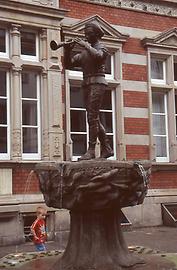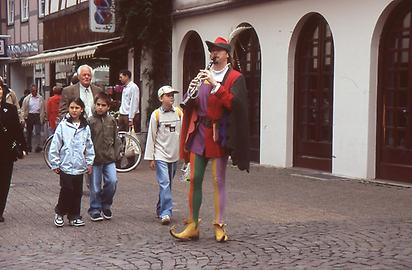The rats are back in Hameln!#
By

Photo: G. Jontes, under CC BY 4.0

Photo: G. Jontes, under CC BY 4.0

Photo: G. Jontes, under CC BY 4.0

Photo: G. Jontes, under CC BY 4.0

Photo: G. Jontes, under CC BY 4.0
The city Hameln Hameln,Deutschland in Lower Saxony on the river Weser calls itself today officially „Rattenfängerstadt“, i.e. city of the catcher of rats. Hameln is one of the locations along the German story road.
A scary local legend became intrinsically connected with the city of Hameln and German culture due to the fairy tales and legends by the famous brothers Jakob and Wilhelm Grimm in their book “Deutsche Sagen” (1816).
In Hameln, the catcher of rats is omnipresent. A beautiful fountain reminds us of him, but also guides of the old city, dressed in medieval clothes supposedly similar to the ones of the catcher of rats.
In 2004 the city came up with the idea, like other cities did, to show off their name-giving animals in a humorous and artistic fashion. In Hameln of course the animals are rats that at some stage a foreigner was able to remove from the city. The reward offered to do so was not given to him. He took revenge by using the same whistle he had used to lure the rats from the city to lure all children out of the city and made them disappear forever.
This legend was first recorded in the middle of the 15th century and quotes records of 1284 mentioning “all children leaving the city”. Today it is assumed that the facts behind this are that rich noblemen needed young people in their quest to colonize parts of the wild land in the East, hence hiring many young persons to come with them. The brothers Grimm are quoting as source N. Kirchmayer: „Vom unglücklichen Ausgang der hamelschen Kinder“ („The unfortunate departure of the children of Hameln”) that was published in 1702 in Dresden and Leipzig. The Grimm version in a rudimentary translation reads as follows:
The children of Hameln (Legend)#

Photo: G. Jontes, under CC BY 4.0
In 1294 a strange man appeared in Hameln. He wore a multicoloured dress, hence he was often called „coloured man“. He claimed to be a professional catcher of rats. He promised to rid the city of all rats in exchange for a sum that was agreed on after some negotiations. The catcher of rats pulled out a whistle. As he started to whistle, rats were coming from all their hiding places and gathered around him. When he was sure that not a single rat was missing he started to leave the city and all rats followed. He made his way to the river Weser and stepped into the fast flowing water. The rats followed into the current and drowned.
After he had gotten rid of the nuisance of the rats the people of the city regretted to have agreed on the substantial payment. Using all kinds of excuses they refused to pay. The catcher of rats left angrily.
However, he returned. Some say at 7 am on June 26, others claim it was mid-day. Anyway, this time he came dressed like a hunter, with a grim face and a strange red hat. He went through the city lanes whistling like he had done for the rats. And, behold!, this time not rats came out of the houses but children, all children of age 4 or more, including the almost grown up daughter of the mayor of the city. The children followed him out of the city to a mountain and he made them disappear in the mountain in a miraculous way.
At least this is what one of the nannies reported that had followed with a small child on her arm, but had turned around and reported what had happened. Parents ran out of the city, searching for the children with grief in their hearts. Mothers moaned and cried. From now on messengers where send out on foot, on horses, on boats to all villages and cities nearby to find the children, or at least some of the 130 that had disappeared.
Some report that two children did return and not follow the others into the mountain. However, one of them was blind so could not point out the place of disappearance, the other one was dumb so was not forced by the whistling to follow all the way. Some mention a third child that returned to get something warmer to wear and thus escaped the catastrophe, since on returning the catcher of rats and the children had disappeared in hole in the mountain that afterwards was just visible as dent in the mountain and remains as such till today.